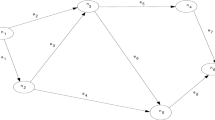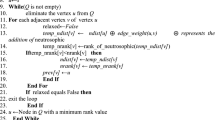Abstract
The shortest path problem as a core combinatorial problem in graph theory that can be applied in various fields such as project scheduling, routing, transportation, network, operation research, and computer science. The main objective of this problem is to find the path having minimum length between any pair of nodes (or vertices). In this study an algorithm was applied in order to find the shortest path having single-valued triangular neutrosophic numbers via score function. A real case study was introduced and solved by this algorithm for the purpose of showing the applicability in real-world problems.
Access this chapter
Tax calculation will be finalised at checkout
Purchases are for personal use only
Similar content being viewed by others
References
Broumi, S., Bakali, A., Talea, M., & Smarandache, F. (2016). Isolated single valued neutrosophic graphs. Neutrosophic Sets and Systems, 11, 74–78.
Broumi, S., Talea, M., Smarandache, F., & Bakali, A. (2016). Single Valued Neutrosophic Graphs: Degree, Order and Size, IEEE International Conference on Fuzzy Systems (FUZZ) (pp. 2445–2451).
Broumi, S., Talea, M., Bakali, A., & Smarandache, F. (2016a). Single valued Neutrosophic graphs. Journal of New Theory, N, 10, 86–101.
Broumi, S., Talea, M., Bakali, A., & Smarandache, F. (2016b). On bipolar single valued Neutrosophic graphs. Journal of New Theory, N11, 84–102.
Broumi, S., Talea, M., Bakali, A., & Smarandache, F. (2016c). Interval valued Neutrosophic graphs. Critical Review, 12, 5–33.
Broumi, S., Smarandache, F., Talea, M., & Bakali, A. (2016d). An introduction to bipolar single valued Neutrosophic graph theory. Applied Mechanics and Materials, 841, 184–191.
Broumi, S., Smarandache, F., Talea, M., & Bakali, A. (2016f). Decision-Making Method Based On the Interval Valued Neutrosophic Graph, Future technologie (pp. 1–8). IEEE.
F. Smarandache,” Refined Literal Indeterminacy and the Multiplication Law of Sub-Indeterminacies,” Neutrosophic Sets and Systems, 9, 2015, pp.58.63.
Broumi, S., Bakali, A., Talea, M., & Smarandache, F. (2016h). Shortest path problem under triangular fuzzy Neutrosophic information, IEEE 10th international conference on software, Knowledge, Information Management & Applications (SKIMA) (pp. 169–174).
Broumi, S., Bakali, A., Talea, M., & Smarandache, F. (2016i). Computation of Shortest Path Problem in a Network with SV-Trapezoidal Neutrosophic Numbers, International Conference on Advanced Mechatronic Systems (pp. 417–422).
Çubukçu, R. (2008). Minimizing Time And Cost Risks Using Scheduling in Project Management, Unpublished Doctoral Thesis. Adana: Çukurova University, Institute of Science.
Soltani, A., & Haji, R. (2007). A project scheduling method based on fuzzy theory. Journal of Industrial and Systems Engineering, 1(1), 70–80.
Kolaylıoğlu, Ö. (2006). Project management and project management in civil engineering, unpublished Master's thesis. Izmir: Dokuz Eylul University Institute of Social Sciences.
Kurt, Ö. (2006). Project planning and programming technics; An application in construction sector, Unpublished Master's Thesis. Antalya: Akdeniz University Institute of Social Sciences.
Kökçam, H. A., & Engin, O. (2010). Solving the fuzzy project scheduling problems with meta-heuristic methods. Journal of Engineering and Natural Sciences, Sigma, 28, 86–101.
Sönmez, E. (2007). Why is the project management?, Unpublished Master's Thesis. Istanbul: Mimar Sinan Fine Arts University Institute of Science.
Durucasu, H., İcan, Ö., Yeşilaydın, G., Gülcan, B., & Karamaşa, Ç. (2015). Project scheduling by means of fuzzy CPM method: An implementation in construction sector. Ege Academic Review, 15(4), 449–466.
Spinner, M. (1997). Project Management, Principles and Practices. New Jersey: Prentice-Hall.
A. Ngoor, M. M. Jabarulla, Multiple labeling Approach For Finding shortest Path with Intuitionistic Fuzzy Arc Length, International Journal of Scientific and Engineering Research,V3,Issue 11,pp.102-106,2012.
Okada, S., & Soper, T. (2000). A shortest path problem on a network with fuzzy arc lengths. Fuzzy Sets and Systems, 109, 129–140.
Kumar, A., & Kaur, M. (2011a). Solution of fuzzy maximal flow problems using fuzzy linear programming. World Academy of Science and Technology., 87, 28–31.
Majumdar, S., & Pal, A. (November 2013). Shortest path problem on intuitionistic fuzzy network. Annals of Pure and Applied Mathematics, 5(1), 26–36.
Kumar, A., & Kaur, M. (2011b). A new algorithm for solving shortest path problem on a network with imprecise edge weight. Applications and Applied Mathematics, 6(2), 602–619.
Yadav, A. K., & Biswas, B. R. (2009). On searching fuzzy shortest path in a network. International Journal of Recent Trends in Engineering, 2(3), 16–18.
Jayagowri, P., & Geetha Ramani, G. (2014). Using Trapezoidal Intuitionistic Fuzzy Number to Find Optimized Path in a Network. Advances in Fuzzy Systems, 1–6.
Hernandes, F., Teresa Lamata, M., Verdegay, J. L., & Kami, A. Y. (2007). The shortest path problem on networks with fuzzy parameters. Fuzzy Sets and Systems, 158, 1561–1570.
Kumar, G., Bajaj, R. K., & Gandotra. (2015). Algorithm for shortest path problem in a network with interval valued intuitionistic trapezoidal fuzzy number. Procedia Computer Science, 70, 123–129.
Broumi, S., Bakali, A., Talea, M., Smarandache, F., & Ali, M. (2017). Shortest path problem under bipolar Neutrosophic setting. Applied Mechanics and Materials, 859, 59–66.
Smarandache, F. A unifying field in logics Neutrosophy: Neutrosophic probability, set and logic., 1998. Rehoboth: American Research Press.
Biswas, P., Pramanik, S., & Giri, B. (2016). Some distance measures of single valued Neutrosophic hesitant fuzzy Sets and their applications to multiple attribute decision making. F. Smarandache, & S. Pramanik içinde, in new trends in Neutrosophic theory and applications (pp. 27–34). Brussels: Pons Publishing House.
Wang, H., Smarandache, F., Zhang, Y., & Sunderraman, R. (2010). Single Valued Neutrosophic Sets. Multispace and Multistructure, 410–413.
Abdel-Basset, M., Mohamed, M., Zhou, Y., & Hezam, I. (2017). Multi-Criteria Group Decision Making Based on Neutrosophic Analytic Hierarchy Process. Journal of Intelligent & Fuzzy Systems, 4055–4066.
Stanujkic, D., Zavadskas, E., Smarandache, F., Brauers, W., & Karabasevic, D. (2017). A Neutrosophic Extension of the Multimoora Method. Informatica, 181–192.
Author information
Authors and Affiliations
Corresponding author
Editor information
Editors and Affiliations
Rights and permissions
Copyright information
© 2021 The Author(s), under exclusive license to Springer Nature Switzerland AG
About this chapter
Cite this chapter
Koca, G., Demir, E., İcan, Ö., Karamaşa, Ç. (2021). Analyzing Shortest Path Problem via Single-Valued Triangular Neutrosophic Numbers: A Case Study. In: Smarandache, F., Abdel-Basset, M. (eds) Neutrosophic Operational Research. Springer, Cham. https://doi.org/10.1007/978-3-030-57197-9_25
Download citation
DOI: https://doi.org/10.1007/978-3-030-57197-9_25
Published:
Publisher Name: Springer, Cham
Print ISBN: 978-3-030-57196-2
Online ISBN: 978-3-030-57197-9
eBook Packages: Business and ManagementBusiness and Management (R0)




